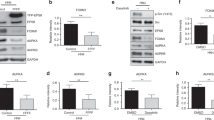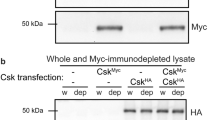Abstract
The vav proto-oncogene encodes a protein with multiple modulae domains that enable it to function as a mediator, linking tyrosine signaling to downstream events in hematopoietic cells. Circumstantial evidence suggests that protein-protein interactions exerted by two of these domains, the Src homology 2 (SH2) and the Src homology 3 (SH3), play an important role in the regulation of Vav activity. To study the relevance of the SH3 domain for the function of vav as a transforming gene, we have created several mutations in the SH3 domain located at its carboxy region. Substitution of the non-conserved aspartic acid 797 (to asparagine, D797N) retained the transforming potential of the vav oncogene, whereas substitutions of five highly conserved amino-acids: alanine 789 (to asparagine, A789N), leucine 801 (to arginine, L801R), tryptophan 821 (to arginine, W821R), glycine 830 (to valine, G830V) and valine 837 (to glutamic acid, V837E) greatly reduced its transforming potential. The mutant proteins resemble Vav in many biochemical properties; however, while the transforming mutant protein (D797N) associates with several unidentified proteins in a manner similar to that of Vav, the non-transforming mutant Vav proteins react very poorly with these proteins. Among the known Vav-interacting proteins, hnRNP-K associates with all mutant proteins except A789N and V837E whereas binding of Zyxin to any of the mutant proteins is not affected. Taken together, our results clearly demonstrate that the SH3 domain has a positive effect on vav activity and is needed for vav transformation. The vavSH3C associating protein(s) that are crucial for its activity as a transforming gene have probably not yet been identified.
This is a preview of subscription content, access via your institution
Access options
Subscribe to this journal
Receive 50 print issues and online access
$259.00 per year
only $5.18 per issue
Buy this article
- Purchase on Springer Link
- Instant access to full article PDF
Prices may be subject to local taxes which are calculated during checkout
Similar content being viewed by others
Author information
Authors and Affiliations
Rights and permissions
About this article
Cite this article
Groysman, M., Nagano, M., Shaanan, B. et al. Mutagenic analysis of Vav reveals that an intact SH3 domain is required for transformation. Oncogene 17, 1597–1606 (1998). https://doi.org/10.1038/sj.onc.1202074
Received:
Revised:
Accepted:
Published:
Issue Date:
DOI: https://doi.org/10.1038/sj.onc.1202074
Keywords
This article is cited by
-
EZH2 promotes neoplastic transformation through VAV interaction-dependent extranuclear mechanisms
Oncogene (2018)
-
Vav1 mutations identified in human cancers give rise to different oncogenic phenotypes
Oncogenesis (2018)
-
An active form of Vav1 induces migration of mammary epithelial cells by stimulating secretion of an epidermal growth factor receptor ligand
Cell Communication and Signaling (2006)
-
Translational regulation by the p210 BCR/ABL oncoprotein
Oncogene (2004)



